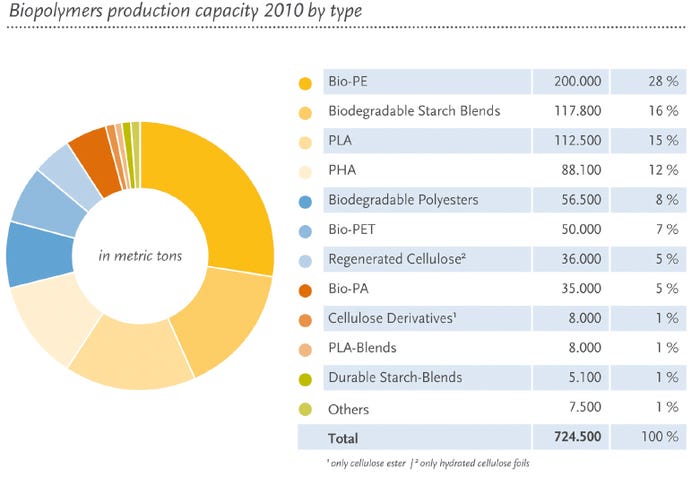Global bioplastics production capacity will more than double from 2010 to 2015, with capacity already forecast to exceed 1 million tonnes in 2011, propelled by the expansion of bioplastics into an ever-increasing number of applications, ranging from packaging to automotive to toys. Stating that "bioplastics are in demand as never before," the study was presented at interpack by the European Bioplastics association, working in conjunction with the University of Applied Sciences and Arts of Hanover.
May 24, 2011
Global bioplastics production capacity will more than double from 2010 to 2015, with capacity already forecast to exceed 1 million tonnes in 2011, propelled by the expansion of bioplastics into an ever-increasing number of applications, ranging from packaging to automotive to toys. Stating that "bioplastics are in demand as never before," the study was presented at interpack by the European Bioplastics association, working in conjunction with the University of Applied Sciences and Arts of Hanover.
The study forecasts that bioplastics production capacity will increase to 1.7 million tonnes by 2015, up from around 700,000 tonnes in 2010. Production in the first half of 2011 was already past 900,000 tonnes, with the one-million-tonne mark to be passed before year end.
Biopolymers production |
Biopolymers production |
The composition of global production volume is also undergoing changes. In 2010, the bioplastics branch primarily produced biodegradable materials, totaling around 400,000 tonnes, compared to 300,000 tonnes of biobased commodity plastics. This ratio will be reversed in the coming years, despite overall growth. In the near future, biobased commodity plastics, with a total of around 1 million tonnes, will make up the majority of production capacity in 2015. Biodegradable materials are slated for substantial growth and are forecast to reach about 700,000 tonnes a that time.
The report called Europe is the world's "largest and most interesting market" for bioplastics, with the region also acting as the leader in research and development. Production, however, is growing most markedly in Asia and South America.
During the interpack trade fair (May 12-18, Düsseldorf), European Bioplastics exhibited a cup made of polylactic acid (PLA), which Danone has used for its premium Activia brand yogurt on the German market since the beginning of April 2011. The association said that the bioplastics sector is developing rapidly, growing at around 20%/yr, and not just in packaging with applications in automotive or consumer electronics, as well as catering, textiles, and agriculture.
For Brazilian plastics and chemical giant, Braskem, this year's interpace was the first that it participated in. Amanda Klein, who works in market for the company, said the event was a success. "Our range of biopolymers attracted a high level of interest among trade visitors from all over the world," Klein said, "and we are confident that we will be participating again at the next interpack, ideally with even more stand space than this time."
On May 18, the global capacity for renewable chemicals increased by 500 tonnes, when Elevance Renewable Sciences announced the completion of a 1 million-pound production run of specialty chemicals made from renewable feedstocks. The company noted that this is a significant increase from its previous 40,000-lb production runs (approximately 20 metric tons).
The 1 million-lb production run was conducted at toll manufacturing locations in the U.S., while Elevance finalizes construction at its Indonesian plant in partnership with Wilmar. The specialty chemicals produced include alpha olefins and novel esters.
The growth in the market was on display May 16, when biobased, compostable, and sustainable plastics manufacturer Cereplast reported first quarter revenues of $7.2 million, compared to $0.3 million for the first quarter of 2010. Cereplast said the increase is the result of the significant growth in order flow from contracts signed in the last two quarters.
The company offered 2011 revenue guidance of $28.0 million to $34.0 million, up from the original guidance of $24.0 million to $32.0 million and representing a significant increase over 2010 revenue of $6.3 million.
In a press release, Frederic Scheer, Cereplast chairman and CEO, said the first quarter reflected "the initial quarter of significant revenues for the company", citing momentum won from legislation banning the use of plastic bags and suggesting the use of bioplastic in the European Union and other emerging markets, as well as higher commodities costs.
About the Author(s)
You May Also Like



